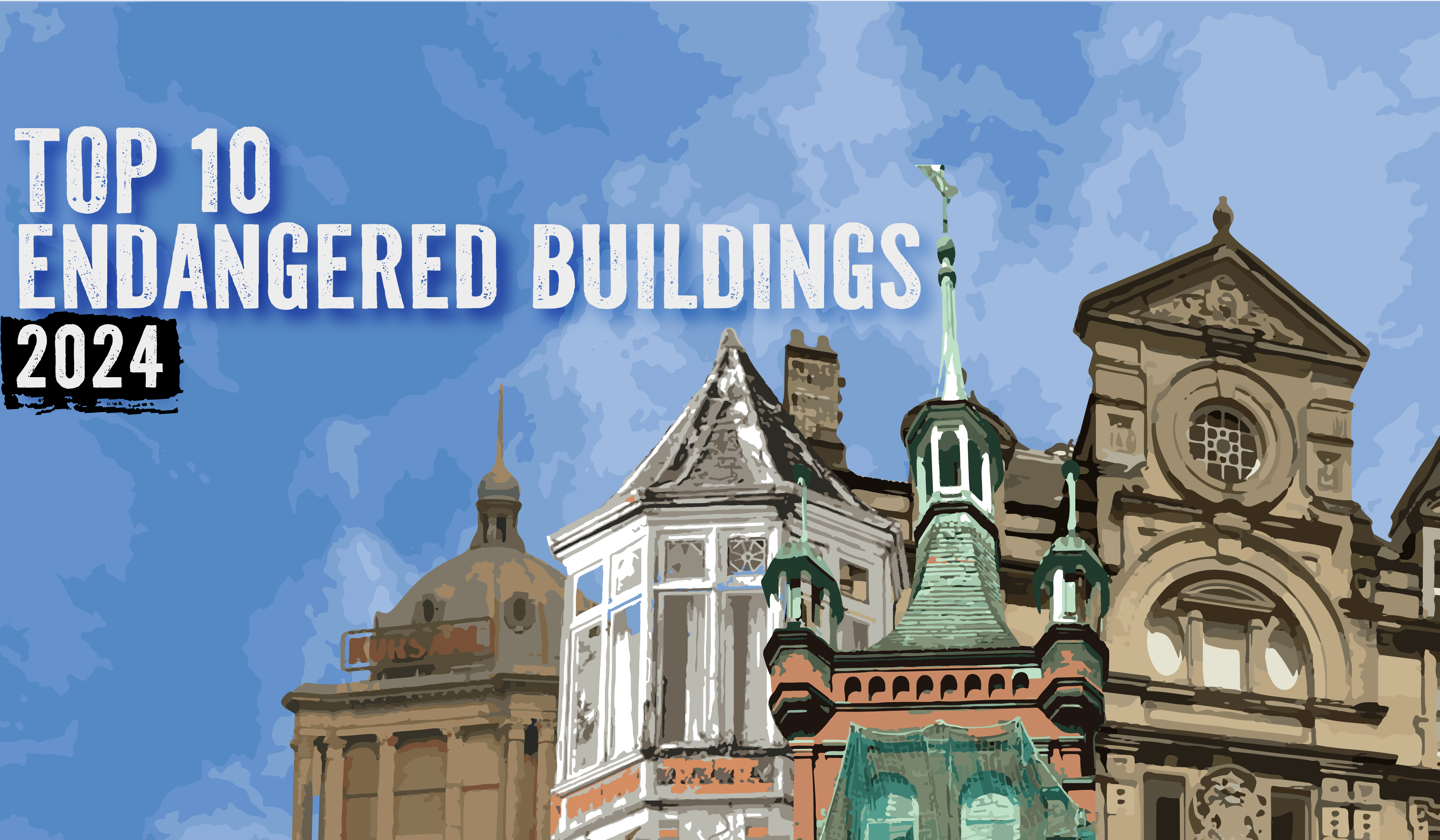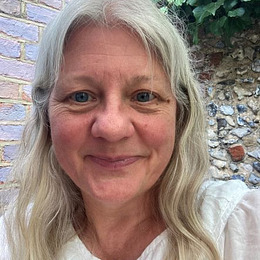The Top Ten Endangered Victorian and Edwardian Buildings list 2024 has been revealed by the Victorian Society’s President

Graphic: Clark Patient
The buildings in the Top Ten are nationally important Grade II* and Grade II listed buildings including one scheduuled monument, in real risk of being lost if action is not taken immediately.
The 2024 list includes a requisitioned school where author Vera Brittain nursed during WWI, the last of one of the world’s first purpose-built amusement parks, a banqueting hall for the workers, one of the first tennis pavilions in the world, and a building where the first £1m cheque was signed. Details of each of the listed buildings can be found on the links below.
Help us fight to save great Victorian and Edwardian architecture by joining the Society here or click here to donate to help us continue our campaigns. You can also sign up for our free monthly newsletter here.
Griff Rhys Jones, Victorian Society President, said:
‘As always, this sad (but fascinating) list of buildings is a testament to the excitement, variety and invention of the Victorian Age. Nobody should dismiss the 19th-century British for their social and political achievements, or their legacy. There is so much to cherish. Here is imagination and delight in a church like St Luke’s. Foresight and genuine social awareness in a sturdy educational building and schools. Wonder in a Newcastle Banqueting Hall. Industry in Smethwick and Cardiff. Even the exuberance of the Kursaal stands as a record of Victorian and advanced industrial legislation that offered paid holidays to ordinary working people. But on another level, how extraordinary to see the genius of an architect like Norman Shaw here. How terrifying to see buildings I have known loved or used all my life in Southend and Cardiff in need of rescue. But come on. Look at the character on display here. They all add colour and story to any urban landscape. Their restoration and reuse make huge commercial sense. They are attractions in themselves. They are already destinations. They should be part of local pride. What do we want? A parking lot? A faceless block in their place? A slew of new carbon pollution? When they have so much colour, continuity and history on their side already. In the middle of a welter of greenwashing and a gush from developers about “sustainability”, the only green solution is recycling, the only carbon-neutral approach is retro-fitting. These are ready-made fascinators, waiting for new uses. Too many end up in the hands of owners who hope that deliberate neglect will allow them to demolish them. We say “get off the pot”. Be imaginative. Join us to show your support for prompt re-use. Join us at the Victorian Society in urging on these national treasures. And many others like them.’
The Victorian Society’s Top 10 Endangered Buildings 2024:
• Kennington Boys’ School (Cormont Road School), Lambeth. Grade II, Architect: T J Bailey, 1898
• The Kursaal, Southend-on-Sea, Essex. Grade II, Architect: George Sherrin, 1898-99
• Jesmond Dene Banqueting Hall, Newcastle Upon Tyne. Grade II, John Dobson, extended to provide a gatehouse, reception hall and display room, Norman Shaw, 1860-62 and 1869/70
• The former Bramcote Tennis Pavilion, Scarborough, N. Yorkshire. Grade II Architect: John Hall, 1885
• St Luke’s Chapel, Nottingham City Hospital, Nottinghamshire. Grade II, Architect: Arthur Marshall, 1902
• St Martins (formerly Roslyn Hoe), Ilfracombe, Devon. Grade II Architect: WM Robbins of Ilfracombe, 1880
• Chances Glassworks, Smethwick, Sandwell. Scheduled Monument, comprising nine Grade II structures, Architect: Unknown, 1847-60
• St Agnes’ Vicarage and Hall, Liverpool, Merseyside. Vicarage Grade II* and Hall Grade II. Architect: Norman Shaw, 1887
• Former Education Dept Offices, Derby, Derbyshire. Grade II, Architect: Giles & Brookhouse, 1871
• Cardiff Coal Exchange, Butetown, Glamorgan. Grade II*. Architect: Seward & Thomas, 1884-86
James Hughes, Victorian Society Director, said:
‘As in previous years, the 2024 list is one that showcases the extraordinary diversity, interest and quality of Victorian and Edwardian architecture across England and Wales. However, it is one that again highlights the ongoing threat that many face, even buildings of genuinely national importance. Two buildings here have appeared in previous editions of this list, highlighting both their chronic difficulties and their ever more acute need for intervention; and the fact that three of the ten buildings are owned by local authorities is arguably a manifestation of increasingly restrictive Council budgets. But irrespective of their precise circumstances – and those of their owners – all these buildings are united in being important and endangered, and it is imperative that means are found to ensure their short-term survival and to secure their long-term and appropriate reuse.
The list is based on public nominations from across England and Wales, and the buildings selected represent industrial, religious, domestic, and civic architecture from across the nation with unique historical and community significance and value. Nominated buildings must be dated between 1837 and 1914.’
An update on some previous Top Ten Endangered Buildings:
From last year’s list, the Office for the Board of Guardians of Walsall Poor Law Union in the West Midlands was sold at auction and the new owner is in discussion with our Conservation Adviser and the Council’s conservation officer about its future as offices. Blackborough House also from 2023 did not sell last year and is now back on the market looking for a new owner to continue the progress that has been made. After appearing in the Victorian Society’s Top Ten in 2020, the Ex-Prudential offices, Oldham, Greater Manchester building was compulsorily purchased in March 2020 and sold to a new owner. Planning permission was awarded in 2023 for the building to be renovated to provide a hub for businesses, foccussing on the creative, digital and media sectors. Plas Alltran, Holyhead in North Wales, also on our 2020 Top Ten list is nearing completion of restoration work after listed buildings consent was given for four social housing flats together with external and internal works. Burslem Indoor Market (2021 Top 10) was granted Grade II listed status in January 2023 which helps emphasise the importance of the town centre’s Victorian urban fabric. The market is currently not in use, but its new listing will hopefully promote discussions into its future use. In March 2023 North Somerset Council invited applications from architects to overhaul the 150 year old Birnbeck Pier and Birnbeck Island in Weston-super-Mare (2015 Top Ten). The contract is worth £700,000. The 1873 Wesley Chapel in Hartlepool (2014 Top 10) will be reused with a developer in partnership with the council using money from the government’s Town Deal to fund the conservation work. The £4m project was expected to take about 18 months to complete until it was hit by an arson attack in November 2023. The developer and Council hope to accelerate the restoration work on one of the largest chapels in north-east England to transform it into a 36-bedroom boutique hotel with a combined bar and restaurant.


